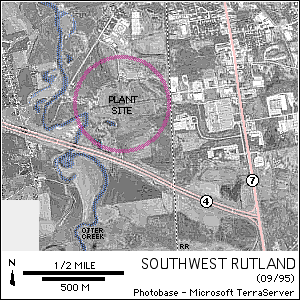
PIPELINE/POWER PLANT PROJECT: RUTLAND POWER PLANT |
|
The electric power plant Vermont Energy Park Holdings (VEPH) proposes to build in Rutland will be a large 1080 MW natural gas- fired facility. As shown on the map below, the plant will be located along the City of Rutland / Rutland Town boundary at the southwest corner of the city and near the southern intersection of highways US4 and US7. The site will include some sixty acres with the main building covering an area of some hundreds of feet per side. Photographs of a similar-sized plant now operating in Oswego, NY, give some idea of the scale of the proposed facility. |

Some aspects of this proposed plant that need to be
considered and evaluated are the following:
![]() Plant Size At ~90' high (9 stories), with stacks
~200' tall (20 stories) the plant will be an overwhelming
presence in the city and town. It will also be the first thing
travelers will see entering Rutland from the west (Route 4) and south
(Route 7).
Plant Size At ~90' high (9 stories), with stacks
~200' tall (20 stories) the plant will be an overwhelming
presence in the city and town. It will also be the first thing
travelers will see entering Rutland from the west (Route 4) and south
(Route 7).
![]() Otter Creek The proposed site lies within or
adjacent to the Otter Creek floodplain. How might this affect plant
construction, operational safety? The site also apparently includes
wetland along the creek (including oxbow ponds and/or marshes). How are
these, and the creek itself, going to be protected / conserved?
Otter Creek The proposed site lies within or
adjacent to the Otter Creek floodplain. How might this affect plant
construction, operational safety? The site also apparently includes
wetland along the creek (including oxbow ponds and/or marshes). How are
these, and the creek itself, going to be protected / conserved?
![]() Water VEPH claims that there will be sufficient
water available for plant cooling purposes, but this has been
questioned. The plant is projected to use an average of 5 million gallons a day
for cooling. Some of this water will come from the Rutland sewage treatment plant.
The remainder will need to come from other sources, probably groundwater.
How will the plant's water needs affect streamflow, groundwater supplies, city water
availability?
Water VEPH claims that there will be sufficient
water available for plant cooling purposes, but this has been
questioned. The plant is projected to use an average of 5 million gallons a day
for cooling. Some of this water will come from the Rutland sewage treatment plant.
The remainder will need to come from other sources, probably groundwater.
How will the plant's water needs affect streamflow, groundwater supplies, city water
availability?
![]() Air Quality Natural gas is the cleanest of hydrocarbon
fuels, but is not pollutant-free. Burning massive amounts of
gas generates corresponding massive amounts of air pollution. Vermont
at present puts negligible amounts (< 20 tons) of CO2 and
pollutants into the atmosphere by generating electricty; this one
plant alone would put Vermont on the air pollution charts. **
Air Quality Natural gas is the cleanest of hydrocarbon
fuels, but is not pollutant-free. Burning massive amounts of
gas generates corresponding massive amounts of air pollution. Vermont
at present puts negligible amounts (< 20 tons) of CO2 and
pollutants into the atmosphere by generating electricty; this one
plant alone would put Vermont on the air pollution charts. **
![]() Emissions Rutland occupies a valley bounded by
hills to the east and west and which narrows to the south. How will
plant emissions - stack gasses and cooling tower water vapor - behave
within the microclimates generated by this topography? **
Emissions Rutland occupies a valley bounded by
hills to the east and west and which narrows to the south. How will
plant emissions - stack gasses and cooling tower water vapor - behave
within the microclimates generated by this topography? **
![]() Noise Power plant operation generates constant, considerable
noise, far more than plant operators usually like to admit. At what distances from
the plant and under what conditions will this noise fade to acceptable levels? **
Noise Power plant operation generates constant, considerable
noise, far more than plant operators usually like to admit. At what distances from
the plant and under what conditions will this noise fade to acceptable levels? **
** See Guldberg comments on these issues.
| COMPANIES | BENNINGTON PLANT | PIPELINES | TRANSMISSION |
Updated: October 9, 1999